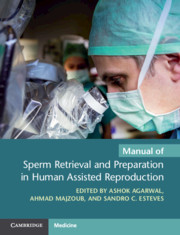Book contents
- Manual of Sperm Retrieval and Preparation in Human Assisted Reproduction
- Cambridge Laboratory Manuals in Assisted Reproductive Technology
- Manual of Sperm Retrieval and Preparation in Human Assisted Reproduction
- Copyright page
- Dedication
- Contents
- Contributors
- Editor Biographies
- Preface
- Part I Introduction
- Chapter 1 Anatomy and Physiology of the Male Reproductive System
- Chapter 2 Evaluation of Candidates for Sperm Retrieval
- Chapter 3 Testicular Histopathology and the Role of Testis Biopsy
- Part II Sperm Retrieval
- Part III Laboratory Handling of Retrieved Sperm
- Index
- References
Chapter 2 - Evaluation of Candidates for Sperm Retrieval
from Part I - Introduction
Published online by Cambridge University Press: 09 April 2021
- Manual of Sperm Retrieval and Preparation in Human Assisted Reproduction
- Cambridge Laboratory Manuals in Assisted Reproductive Technology
- Manual of Sperm Retrieval and Preparation in Human Assisted Reproduction
- Copyright page
- Dedication
- Contents
- Contributors
- Editor Biographies
- Preface
- Part I Introduction
- Chapter 1 Anatomy and Physiology of the Male Reproductive System
- Chapter 2 Evaluation of Candidates for Sperm Retrieval
- Chapter 3 Testicular Histopathology and the Role of Testis Biopsy
- Part II Sperm Retrieval
- Part III Laboratory Handling of Retrieved Sperm
- Index
- References
Summary
There are a variety of management options for male infertility patients. Often, assisted reproductive technology allows for successful pregnancies and live births using an ejaculated semen sample. If the etiology of the infertility precludes a satisfactory ejaculated semen sample, sperm retrieval may be required. Determining if a patient is a candidate for sperm retrieval involves a thorough history and physical exam, semen analysis, endocrine evaluation and, likely, genetic assessment. Men who are candidates for sperm retrieval may be azoospermic or anejaculatory. Understanding the etiology of azoospermia is critical to determining the most effective sperm retrieval approach.
- Type
- Chapter
- Information
- Publisher: Cambridge University PressPrint publication year: 2021

